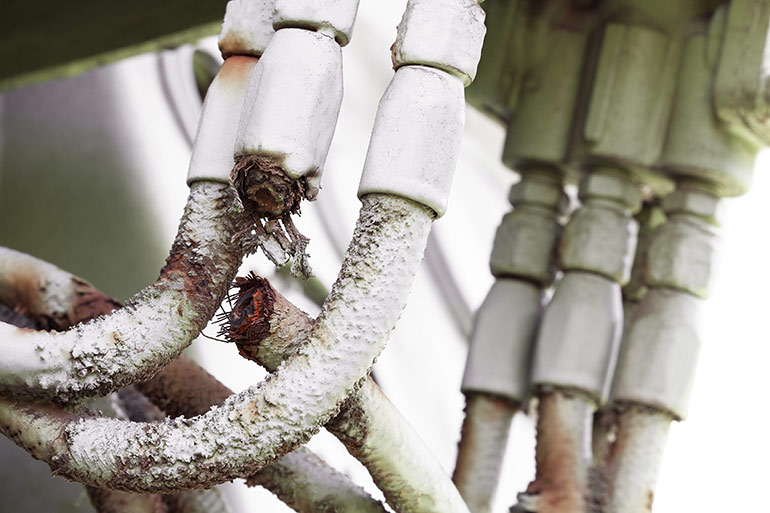By Josh Cosford, Contributing Editor
How long a hydraulic hose should last depends on many factors, not the least of which is who you ask. Some standards want to see hoses changed every few years, yet others are okay up to ten years (such as with the SAE). But do we even need to apply a death clock to hydraulic hoses if they’re properly cared for? The short answer is yes, but that doesn’t mean we must prematurely swap hoses based on counting full moons. Let’s dig into the factors that affect hydraulic hose life.
Applications vary from cleanroom power units for testing NASA rockets to logging equipment trudging through cold mud, so to require the same hose maintenance schedule might not be prudent. You can combine industry recommendations with applicational and historical considerations.

Let’s start by saying you should probably change your hydraulic hoses within ten years max. Even a hydraulic hose sitting unused in your warehouse should be scrapped after ten years, as even general ambient deterioration factors such as sunlight, moisture and ozone will degrade the hose over time.
When you factor in large temperature swings, such as with arctic machinery resting overnight in frigid climates and then firing up the next morning for a day of operation, the expansion and contraction of the rubber accelerates aging. In such circumstances, a hose may swing across a hundred degrees of variability, fatiguing the structure of the inner tube and cover.
Combining pressure fluctuations or spikes within a deteriorating hose also reduces its lifespan. Imagine your already-weakened hose being subjected to pressure spikes as the machine operator slams his excavator’s hydraulic hammer into the side of a building he’s demolishing, for example. Conversely, an industrial conveyor using a hydraulic motor drive seeing relatively constant ambient conditions while subjected to fewer of the pressure spikes of mobile machine will result in highly reliable hoses.
You can predict hose service life by factoring in specific machine and operation conditions. I’m never a fan of arbitrarily changing hydraulic parts that don’t need it, but unless you have your own crimper and stock of hose and fittings to create new hoses on the fly, it’s likely a failure will result in downtime. Replacing a thousand dollars in hoses every three years on your production-critical machines is nothing compared to the thousands of dollars per hour you lose when your machine goes down. And try telling your customers you can’t deliver their order because your local hose shop has to bring in the 6-wire hose on your injection molding machine.
It’s always a good idea to track your maintenance activities, even from unexpected downtime. You need to understand how your own application and ambient environment affect the life of your hoses. Manufacturers and standardization bodies can’t know what you know, which is why they can only offer guidelines. Knowing that your machine always seems to blow a pressure line every few years helps you stay on top of preventive maintenance, which avoids costly downtime.
Regardless of your machine or environment, you can put measures in place to increase the useful life of your hydraulic hoses. For one, only operate your machine within its design specifications. If your machine was designed to run at 2,500 psi, don’t push things to 3,000 psi just because you want more force. The hoses selected may be rated for only 2,500 psi, and pushing higher will reduce reliability.
Additionally, using hose wrap not only protects from abrasion but the sleeve style also reduces exposure to ambient chemicals, industrial fallout or road film. And while protecting the outside of your hose, you should consider the health of its inside. Keeping your oil cool and dry will prevent oxidation, hardening and cracking of the inner tube. By cool, of course, I mean within the normal operating limits of hydraulic machinery (think 120°F [50°C], give or take). And you’d be surprised at the amount of water hydraulic oil can hold in solution without the obvious appearance of free water. Most NBR hoses are okay with water, but your hydraulic oil isn’t. It can oxidize and sludge, which could result in the degrading of the nitrile tube.
If machine uptime is the most critical factor in deciding whether to change your hoses every five years, by all means, change them. Some factories, such as Tier 1 automotive suppliers, run at capacity with just-in-time production that prioritizes uptime. You know your machine, and you know your production requirements, so use the preceding information to schedule a hose changeout program that works for you. And lastly, if your hose looks like it requires changing; absolutely change it!
Filed Under: Components Oil Coolers, Engineering Basics, Hose & Tubing, Hose Assembly Tips